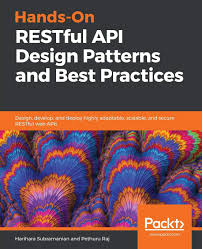Hands-On RESTful API Design Patterns and Best Practices: A Comprehensive Guide
This white paper explores the core principles, best practices, and design patterns outlined in "Hands-On RESTful API Design Patterns and Best Practices," a guide to creating robust, scalable, and maintainable RESTful APIs.
1. Introduction
REST (Representational State Transfer) is an architectural style for designing networked applications, particularly for the Web. RESTful APIs leverage HTTP methods (GET, POST, PUT, DELETE, etc.) to interact with resources, making them a cornerstone of modern web development. This white paper delves into key design principles, common patterns, and best practices to guide the development of effective and maintainable RESTful APIs.
2. Core Principles of RESTful API Design
- Client-Server Architecture: Decouples clients from servers, allowing independent evolution and scaling.
- Statelessness: Each request from a client must contain all the information necessary to understand and process the request.
- Cacheability: Responses should be explicitly labeled as cacheable or non-cacheable to optimize performance.
- Layered System: The architecture should be layered, allowing intermediaries (e.g., proxies, gateways) to be introduced without affecting client-server interactions.
- Code on Demand (Optional): Clients can temporarily extend server functionality by downloading and executing code.
3. Key Design Patterns
- Resource-Oriented Design: Organizing APIs around resources (e.g., users, products, orders) and using HTTP methods to interact with them.
- Versioning: Implementing versioning strategies (e.g., URL versioning, header-based versioning) to manage API changes and maintain compatibility.
- Error Handling: Implementing consistent and informative error handling mechanisms, including appropriate HTTP status codes and meaningful error messages.
- Authentication and Authorization: Implementing secure authentication and authorization mechanisms (e.g., OAuth 2.0, JWT) to protect API endpoints.
- Caching: Utilizing caching strategies (e.g., client-side caching, server-side caching) to improve API performance and reduce server load.
- Rate Limiting: Implementing rate limiting mechanisms to prevent abuse and ensure fair usage of the API.
- Pagination: Implementing pagination for large datasets to improve performance and prevent overloading clients.
4. Best Practices
- Use meaningful and consistent naming conventions: Choose clear and concise names for resources, endpoints, and parameters.
- Follow HTTP method conventions: Use appropriate HTTP methods (GET, POST, PUT, DELETE, PATCH) for each operation.
- Design for discoverability: Provide clear and concise documentation, including API specifications (e.g., OpenAPI/Swagger).
- Ensure security: Implement appropriate security measures to protect the API from unauthorized access and attacks.
- Monitor and analyze API usage: Track API usage metrics (e.g., request volume, response times, error rates) to identify performance bottlenecks and areas for improvement.
- Version APIs carefully: Plan for future changes and implement versioning strategies to minimize disruption to existing clients.
5. Use Cases
- E-commerce APIs: Exposing product catalogs, managing orders, processing payments.
- Social Media APIs: Enabling third-party applications to interact with social media platforms.
- IoT APIs: Collecting and processing data from IoT devices.
- Mobile App APIs: Powering mobile applications with data and functionality.
- Internal APIs: Enabling communication and data exchange between internal systems.
6. Tools and Technologies
- API Gateways: (e.g., Kong, Apigee, Tyk) - Manage and secure API traffic, enforce rate limits, and provide analytics.
- API Documentation Tools: (e.g., Swagger, OpenAPI) - Generate interactive API documentation from code.
- Testing Tools: (e.g., Postman, JMeter) - Test API performance, functionality, and security.
7. References
- "RESTful Web Services" by Leonard Richardson and Sam Ruby
- "REST API Design Rulebook" by Mark Masse
- "Designing Evolvable Web APIs with ASP.NET" by Glenn Block and Brian Ray
- OpenAPI Specification: https://www.openapis.org/
- RESTful API Guidelines: https://restfulapi.net/
8. Conclusion
By adhering to RESTful principles and best practices, developers can create robust, scalable, and maintainable APIs that power modern applications and services. This guide provides a solid foundation for designing and developing effective RESTful APIs that meet the demands of today's interconnected world.
Disclaimer: This white paper provides a general overview of RESTful API design principles and best practices. The specific requirements and implementations will vary depending on the individual project and its specific needs.
This information is for general knowledge and informational purposes only.
Dis



